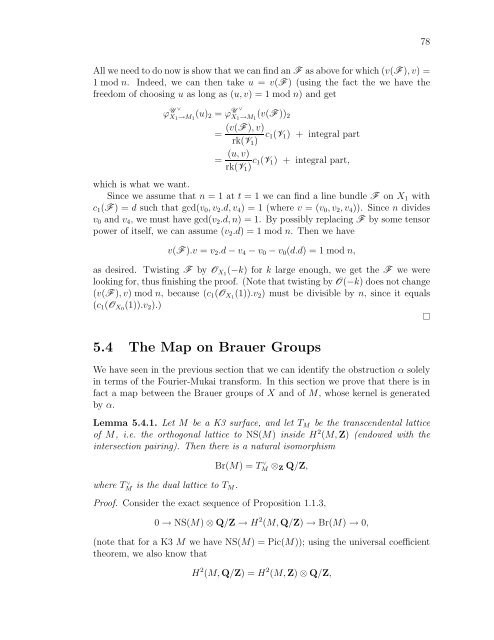derived categories of twisted sheaves on calabi-yau manifolds
derived categories of twisted sheaves on calabi-yau manifolds
derived categories of twisted sheaves on calabi-yau manifolds
You also want an ePaper? Increase the reach of your titles
YUMPU automatically turns print PDFs into web optimized ePapers that Google loves.
All we need to do now is show that we can find an F as above for which (v(F ), v) =<br />
1 mod n. Indeed, we can then take u = v(F ) (using the fact the we have the<br />
freedom <str<strong>on</strong>g>of</str<strong>on</strong>g> choosing u as l<strong>on</strong>g as (u, v) = 1 mod n) and get<br />
U ∨<br />
ϕX1→M1 (u)2<br />
U ∨<br />
= ϕX1→M1 (v(F ))2<br />
= (v(F ), v)<br />
rk(V1) c1(V1) + integral part<br />
= (u, v)<br />
rk(V1) c1(V1) + integral part,<br />
which is what we want.<br />
Since we assume that n = 1 at t = 1 we can find a line bundle F <strong>on</strong> X1 with<br />
c1(F ) = d such that gcd(v0, v2.d, v4) = 1 (where v = (v0, v2, v4)). Since n divides<br />
v0 and v4, we must have gcd(v2.d, n) = 1. By possibly replacing F by some tensor<br />
power <str<strong>on</strong>g>of</str<strong>on</strong>g> itself, we can assume (v2.d) = 1 mod n. Then we have<br />
v(F ).v = v2.d − v4 − v0 − v0(d.d) = 1 mod n,<br />
as desired. Twisting F by OX1(−k) for k large enough, we get the F we were<br />
looking for, thus finishing the pro<str<strong>on</strong>g>of</str<strong>on</strong>g>. (Note that twisting by O(−k) does not change<br />
(v(F ), v) mod n, because (c1(OX1(1)).v2) must be divisible by n, since it equals<br />
(c1(OX0(1)).v2).)<br />
5.4 The Map <strong>on</strong> Brauer Groups<br />
We have seen in the previous secti<strong>on</strong> that we can identify the obstructi<strong>on</strong> α solely<br />
in terms <str<strong>on</strong>g>of</str<strong>on</strong>g> the Fourier-Mukai transform. In this secti<strong>on</strong> we prove that there is in<br />
fact a map between the Brauer groups <str<strong>on</strong>g>of</str<strong>on</strong>g> X and <str<strong>on</strong>g>of</str<strong>on</strong>g> M, whose kernel is generated<br />
by α.<br />
Lemma 5.4.1. Let M be a K3 surface, and let TM be the transcendental lattice<br />
<str<strong>on</strong>g>of</str<strong>on</strong>g> M, i.e. the orthog<strong>on</strong>al lattice to NS(M) inside H 2 (M, Z) (endowed with the<br />
intersecti<strong>on</strong> pairing). Then there is a natural isomorphism<br />
where T ∨<br />
M<br />
is the dual lattice to TM.<br />
Br(M) = T ∨<br />
M ⊗Z Q/Z,<br />
Pro<str<strong>on</strong>g>of</str<strong>on</strong>g>. C<strong>on</strong>sider the exact sequence <str<strong>on</strong>g>of</str<strong>on</strong>g> Propositi<strong>on</strong> 1.1.3,<br />
0 → NS(M) ⊗ Q/Z → H 2 (M, Q/Z) → Br(M) → 0,<br />
(note that for a K3 M we have NS(M) = Pic(M)); using the universal coefficient<br />
theorem, we also know that<br />
H 2 (M, Q/Z) = H 2 (M, Z) ⊗ Q/Z,<br />
78
















